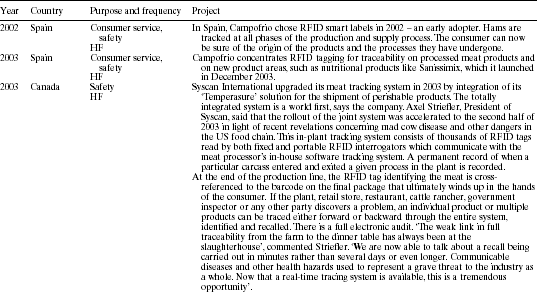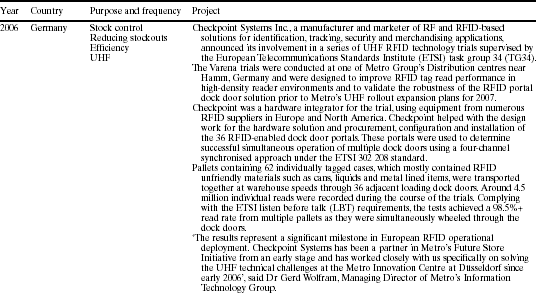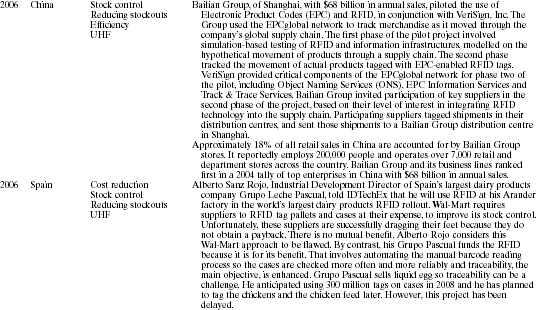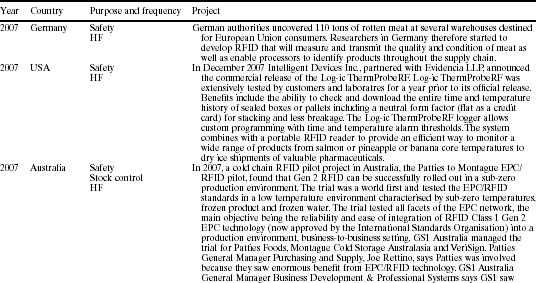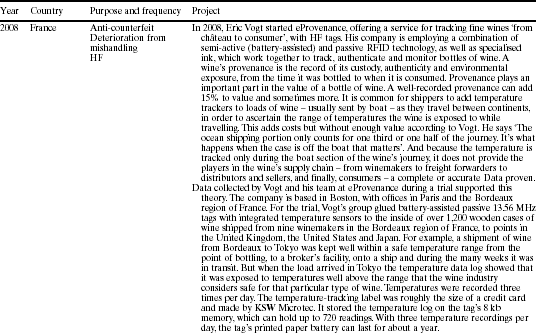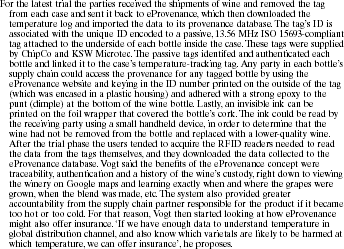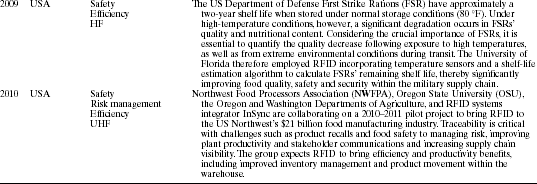Radio-frequency identifiction (RFID) for food and beverage packaging applications
Abstract:
Radio-frequency identification (RFID) can help to tackle many problems in the food and beverage industries such as waste in the supply chain, empty shelves, theft, counterfeiting and recall of debased or dangerous product following a bioterrorism incident or outbreak of foodborne disease. It is currently used on or in only a tiny percentage of food or drink packages, but it may be extensively used before the end of the decade. This chapter explains RFID systems, their benefits, technical functions, and future in food and drink applications.
9.1 Introduction
This chapter explains RFID systems, their benefits, technical functions, and future in food and drink applications. RFID is used on or in only a tiny percentage of food or drink packages, but it may be extensively used before the end of the decade. RFID can help to tackle many problems in this industry such as waste in the supply chain, empty shelves, theft, counterfeiting and recall of debased or dangerous product, including the results of bioterrorism and infection. Some 32 million children under five die of food-related illness every year according to the World Health Organization (WHO). Up to 20 per cent of perishable food is expired on reaching destination according to the US Food and Drug Administration (FDA). That impacts everything from global warming to traffic congestion as trucks return with produce rejected by retailers and RFID can help in all these examples.
However, for now, the major success of RFID lies elsewhere. For 2009, IDTechEx finds the RFID market grew to $5.56 billion, having almost tripled in five years. Being based largely on government-backed military, identity card, financial card, passport and other projects and legally mandated requirements such as animal tagging, this market is recession proof, and is continuing to grow rapidly. Of the total, $2.18 billion consisted of passive tags – those with no battery in them.
There is some legislation that is encouraging but not mandating the use of RFID on food, drink and drugs (see Table 9.1). It is not as specific and compulsory as government requirements to tag passports in 70 countries or – for disease control in farms – dogs in New Zealand or cows in Australia, for example. Some examples are given below.
Table 9.1
Some regulations driving RFID on food and drugs
| Regulation or recommendation that may be followed by legal requirement | Purpose | RFID potential |
| Public Health Security and Bioterrorism Preparedness and Response Act 2002, Section 306 (published in December 2004) | Secure the human and animal food supply. Requires offshore supplier registration, records retention and rapid response to FDA calls for action | Smart tags help quickly trace back to the source of contamination and trace forward to locate tainted supply |
| Sarbanes-Oxley Act, Section 404 | Internal controls accuracy, records retention and integrity of financial reporting | RFID data becomes transaction record for raw materials, WIP, finished goods, inventory and goods in transit |
| FDA policy, ‘Combating Counterfeit Drugs’, published February 2004 and ‘Compliance Policy Guide’, published November 2004 |
Protect the US drug supply from counterfeit drugs through chain-of-custody records and electronic pedigrees. This means each pot of pills, however small, having a unique identification that can be used for full reverse audit to establish authenticity (mass serialisation) | Unique identification on all prescription drugs used in the US, as they move through the supply chain, by 2007, using RFID. This date has now been abandoned and mass serialisation using 2D barcodes is accepted as an interim stage but the general objective remains. However, although database structure has been decided, the FDA has not chosen the frequency and signalling protocol for RFID, leaving it to the industry, which will probably never decide on its own. For example, 30 years on there are still three incompatible types of anti-theft tag because users have not set a standard. There are lessons here for food traceability required to combat accidental and deliberate poisoning, infection, contamination and counterfeiting. |
| European Union requirements for traceability of incoming foods. | ‘One up one down traceability’ by any appropriate method |
Source: IDTechEx.
9.2 Principles of radio-frequency identification (RFID)
Radio-frequency identification (RFID) is the use of radio frequencies to electronically read information, at a distance, on small devices called tags with few problems of orientation, obscuration or reading many at a time. Tags may take many forms but labels are the most popular. RFID is best thought of as an enabling technology like paper or the wheel: like them it is used for very different reasons in different applications. For example, in food and beverage packaging, it is potentially useful for anti-counterfeiting, logistics, including reduction of stockouts and losses in the supply chain, error prevention and anti-theft. Indeed, because an RFID tag can incorporate sensors, it can monitor the time-temperature profile in the supply chain, including the cold supply chain, and identify weakness, even providing evidence in court against hauliers that allow the product to overheat and deteriorate. Certain sophisticated RFID systems can locate the tag from a distance to trace lost or stolen produce and even a fairly basic tag can subsume the anti-theft tag in a shop that sets off an alarm if removed from the premises – one tag does the job of two. Unlike barcodes, most RFID tags can have data electronically added to them at speed at a distance and this can record history, use by dates, etc. They can be made so they are very difficult to counterfeit, emulate or alter without detection and some versions trigger alarms if removed from the produce. Consider when an illegal substance is known to have entered food due to faulty manufacture or terrorist attack. If everything in the supermarket was RFID tagged, each item would have a unique electronic identity and recalls would be rapid and almost 100% efficient. Contrast that with today, when recalls are often incomplete and can take years.
The most important function of RFID, and one which creates the host of benefits, is that it automates procedures by reading an identity number on the tag more accurately, quickly, reliably and often than would otherwise be possible, sometimes 1,000 tags at a time. However, RFID systems, including the tags, typically cost more than alternatives such as barcode systems, Electronic Article Surveillance systems (anti-theft tag systems) and other partial alternatives. RFID tags rarely provide visual information unlike a non-electronic ink that changes colour to indicate overheating has occurred with food and drink. The most popular, low cost RFID tags have much less memory than a 2D barcode. In food and drink applications, the tags are typically disposable and constitute about 50% of the total cost of ownership of the system, despite costing as little as ten cents each if bought at the million level. Tags doing the cleverer functions can cost up to $100.
At minimum, an RFID system consists of a tag and a reader. The tag is useless on its own. Most RFID tags are passive, meaning they do not have their own power supply such as a battery, so they cannot initiate a signal, store sensor data, calculate and send their position, work at more than a few meters range without huge readers or perform other functions seen with the more sophisticated ‘active’ tags. However, most passive tags are read-write, i.e. they can have extra data recorded onto them in addition to the unchangeable unique identification they already possess. The device that does this is sometimes called an interrogator or read-writer and – at hundreds to thousands of dollars – it costs more than a simple reader. A read-write tag also costs more than a read-only tag.
The interrogation frequency strongly influences the performance of an RFID system and the requirements are so different that there will never be only one frequency used for RFID. For passive tags, high frequency (HF) (13.56 MHz) is the favourite frequency in terms of money spent and numbers purchased because range is very controllable, tags can be affordable labels and it is legal worldwide. It is used for passports, secure access, gas cylinders, beer kegs, library books and almost all cards and tickets that work at a distance, for some tagging of small drug packages and in all mobile phones that can be used for buying things by emulating financial cards. Ultra high frequency (UHF) is the other favourite frequency because it sometimes works at longer distance of a few meters, which is useful with larger things such as food and drink cases and pallet loads of those cases, air baggage, etc. Unfortunately, UHF will never be permitted at the same frequency, power level and signalling protocol worldwide because mobile phone companies and military interests had already taken those frequencies. Different bands of UHF frequencies are permitted in different countries, between a range of 850 and 950 MHz or so. Some interrogators can cope with all these frequencies and Wal-Mart wishes to use UHF for primary, secondary and tertiary packaging of food and drink, though that may mean two types of tag and reader – so-called ‘near field’ in order to distinguish small items and ‘far field’ for longer range with large items. In the past, UHF proponents promised to read even obscured cases in food and drink pallet loads and the items in them with near 100% success, but that objective has been quietly abandoned in the face of the high sensitivity of UHF emissions to the water, metal and glass present in most food and drink products.
9.2.1 Mass singulation
The greatest benefit of RFID in the food and drink industry will come from having individually unique electronic identity on every item, i.e. ‘mass sin-gulation’ emulating the way the pharmaceutical industry can trace the provenance of each item where it has an RFID tag or 2D barcode linked to their secure database. In 2007, Kodak even patented an edible form of RFID so the drug tablet itself could be uniquely identified electronically but we are a long way from doing that with food and drink. For now, itemlevel tagging, meaning down to the smallest package, is the focus. That usually means the can of drink or smallest package of food, for example.
9.2.2 Impediments
The impediments to item-level RFID tagging have included, most importantly, affordability but also lack of education, trials and standards, waiting for radio regulations to be eased at UHF in some countries, poor quality of UHF tags and systems and higher price of the often better performing HF ones. These are all gradually being overcome, with affordability being last to be adequately addressed as we discuss later.
Interrogators and their antennas need to be plug-and-play and easier to deploy and move. ‘If I move a smart shelf in my store, I can’t be dealing with customer antennas, co-ax cables and power cables’, says Best Buy’s Bob Freeman. ‘For us to deploy this across 733 stores, we need readers to be under a couple of hundred dollars. We need them to control antennas on a lot of shelving. We need Power over Ethernet. The cost to retrofit a store is enormous. The good news is these are things vendors are working on’. Indeed, TagSense claims to have a basic UHF reader that could be made for $150 and basic HF readers costing only $15 are available. Intelligent UHF readers are nearer to $1,000 though. Another issue, in some sectors, is who will tag the goods, and who gets paid for this. For example, such is the market power of retailers in the West, they often get suppliers to fit anti-theft tags at no cost and some of these retailers have had suppliers fit RFID tags to pallets and cases at no cost in recent years. In neither example does the supplier get a payback. IDTechEx estimates that suppliers of food and drink have spent over $200 million on RFID in this way, far more than for anti-theft tags, and they have complained and quite often have been permitted to stop fitting RFID to pallet loads and cases. However, the Metro supermarket chain in Germany is methodically continuing with its programme involving over 1,000 suppliers and some other food and drink organisations are following.
9.2.3 Benchmark other industries
At item level, the food and drink industry can benchmark what is happening with apparel in the retailing supply chain, where the high price makes the RFID tag cost effective earlier. Over 100 retailers and their suppliers are now either trialling or rolling out RFID-tagged items, yielding two-year payback just from reducing stockouts. The leader, Marks & Spencer in the UK, tags about 200 million items of apparel every year with a very simple read-only 64-bit tag with semi-random numbering. Others prefer the EPC-Global numbering system mimicking barcodes controlled by its parent GS1. Similar things are happening in bookshops and pharmacies drugs but, of course, apparel, books and drugs, being largely dry and non-metallic, are an easier application of UHF RFID than food and drink. In the Americas, there is a strong preference for UHF passive RFID even where its application is troublesome.
9.3 Applications of radio-frequency identification (RFID) in food and beverage packaging
Examples of RFID tagging of food and drink packages are shown in Table 9.2.
9.4 Future trends
There is no evidence that the level of government funding and legislation that drives most expenditure on RFID will be applied to food and drink. That might change if there are massive bioterrorism attacks. More likely, use of RFID on or in food and drink packaging will increase because rapid cost reduction of the tags makes them affordable in these applications and that will be true for primary, secondary and tertiary packaging. A key advance must be RFID labels being made with printed electronics instead of the silicon chip that is currently the dominant part of their cost. Later, the cost of applying a label will be eliminated by printing RFID directly onto packaging. All this will simply emulate what happened with barcodes where a huge barcode label market was established in the 1970s, then it collapsed with 85% of barcodes being printed directly onto things today for under one cent. However, with RFID there will also be the following differences:
• The ink for RFID circuits is expensive, though very little is needed. Barcode ink is the same as the ink used for graphics on the package: it costs very little.
• The RFID can be applied on the inside of any non-metallic packaging because, unlike barcodes, it works through packaging. This improves the appearance of the packaging and it means the thief cannot locate the RFID label for removal when it doubles as an antitheft tag.
• Unlike barcodes, RFID will provide individual identity giving multiple paybacks.
IDTechEx forecasts that this will happen in the latter part of the next ten years and it will be the primary reason why RFID for retail and consumer goods will grow very rapidly. IDTechEx forecasts that tag expenditure worldwide for food and drink, excluding livestock, will rise from only $58 million in 2009 – only 2.4% of all tag expenditure – to $3.89 billion in 2019, which will be 31% of all RFID tag expenditure in that year. That will be driven by the passive tags, that are preferred in this sector, dropping from 12 cents (incorporating a silicon chip) in unit price to 0.35 cents (with the silicon chip replaced by printed electronics) as shown below in Table 9.3.
Table 9.3
IDTechEx forecasts for global sales of RFID passive tags in consumer goods, excluding pallet loads and transit cases, by numbers, unit value and total value

Source: Das R and Harrop P (2009) ‘RFID Forecasts, Players and Opportunities 2009–2019’,IDTechEx.
9.4.1 Printing technology to reduce tag price
The cost reducing conventional passive RFID tags, which consist of an antenna with silicon chip attached, are likely soon to be phased out because simple silicon chips have not reduced significantly in cost for thirty years and reducing chip cost by reducing feature size produces diminishing returns. The cost of a silicon chip factory and its technical support is actually going up exponentially, so the benefits only apply to ever more complex circuits, not RFID chips. The smallest features on state-of-the-art chips can even be unstable. The price-volume sensitivity of RFID in the marketplace is such that chip-based RFID tags will never be produced profitably, i.e. sustainably, for less than a few cents. Consequently, silicon chip RFID has little relevance to replacing over five trillion barcodes yearly or even a modest proportion of them. The lowest achievable costs with chip-based RFID imply that only billions yearly will ever be sold. Indeed, suppliers have already made a trading loss of over $500 million supplying UHF RFID labels in millions yearly onto food and drink cases under mandates from retailers. These heavily loss-making UHF labels are still only selling in a few hundreds of millions yearly, mostly on cases, not at item level.
Printing and similar laminar technology, which will replace the RFID silicon chip, will reduce tag price by 90% or more for very high volumes. It can be applied in two ways. Firstly, the transistors in the chip can be replaced with different circuits or materials with data storage such as the acousto-magnetic metal layers used in the 16-bit Astra Zeneca tags applied to the drug Diprivan for error prevention, where over 40 million have been shipped. When launched in 2002, their 15 cent price was a fraction of the cost of chip-based tags at that time. RFSAW had modest success with a surface acoustic wave RFID made in a similar way to a silicon chip but with fewer, simpler stages and cheaper materials. Fully printing patterns and materials without making transistors can significantly reduce the costs on those for these options.
9.4.2 Fully printed non-transistor technologies
Fully printed non-transistor technologies can, in some cases, reduce the cost by 99% but so far they are seen as too primitive for mainstream use in food and drink, since they are mostly read-only with only a few bits of data and a range of only millimetres to centimeters in most cases. Retailers and their food and drink suppliers prefer 128-bit read-write and they need a range of at least one metre for pallet loads and cases and tens of centimetres at item level. Examples are ink stripe RFID where the stripes are printed in electronic ink, detectable through the food package at a few millimetres. These have been trialled by ACREO in Sweden and by Tako Carton (mReal) in Finland. Somark Innovations, InkSure and Vubiq have offered unique signature printing in electronic inks working at microwave frequencies and some of these inks are approved by the FDA as edible and printed directly on meat, but major market success has so far been elusive.
The nearest to a commercial success has been Menippos, which sold over one million of them on a games card that accessed the internet for a free game, but the food and drink industry has rejected these solutions so far. New ideas keep coming along but they do not necessarily offer what the food and drink industry requires for mainstream use. For example, in Sweden in 2010, iPack announced a fully metallic inkjet printed chipless passive RFID tag on a paper substrate. The tag consists of a microstrip transmission line with distributed shunt capacitors as information coding elements reconfigurable by inkjet printing. Tapering line structures are employed to overcome the limitation of low conductivity and thin film thickness of inkjet printed metal tracks. Measurement results show that the tag features a robust readability over 80 cm reading distance and a high data rate of 1.67 Gb/s. Printing directly onto paper packaging is an exciting prospect and the range is good, but questions remain about whether it can be read-write and have enough data – or will the food and drink industry settle for read-only and fewer bits?
9.4.3 Fully printed transistor technologies
Most impressive in approaching volume RFID requirements of the food and drink industry is Kovio, Inc., a developer of printed silicon electronics on very thin stainless steel foil. Its inkjet printed circuit has over 1,000 transistors and it meets the world’s preferred RFID specification ISO 14443. Cost is projected at two cents or so with considerable potential for further reduction. It is shown in Figure 9.1.
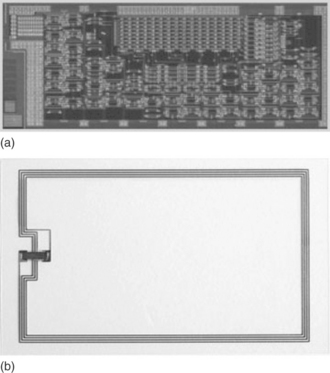
Fig. 9.1 Kovio printed RFID transistor circuit (a) magnified and (b) shown on the antenna in a credit card sized RFID label (source: Kovio).
In 2010, Nissan Chemical Industries, Ltd. (NCI) is commercially producing Kovio’s proprietary silicon ink technology and it supplies Kovio with silicon ink for its RFID products and other strategic applications. In addition, NCI intends to commercialise silicon ink products based on Kovio’s technology in the Asian display industry, helping costs by gaining volume beyond RFID.
9.4.4 Printed organic transistor RFID
Potentially competing with Kovio for highest volume RFID applications in food and drink are companies printing organic transistors which are currently rather large and do not perform as well (only HF and short range as yet, with rather high voltage of operation) but they can be printed reel to reel onto low cost plastic film and may one day cost less than nanosilicon versions, although the inks are currently expensive. PolyIC in Germany and Paru in Korea are among the proponents of this approach. PolyIC has offered development kits for its reel-to-reel printed organic RFID labels in 2010.
Holst Centre, Imec and TNO in the Netherlands have been successful in reporting state-of-the art results in printed organic transistor RFID in recent years. The advance in early 2010 was a 64-bit transponder circuit at 4.3 kb/s which shows a two-fold improvement compared to the result reported in 2009. The new printed circuits operate at lower voltages (down to 10 V), making them more suitable for capacitive and inductive coupling with a readout station. Key to this is the use of a dual gate unipolar transistor technology, adapted from rollable-display company Polymer Vision, one of the partners in the Holst Centre research programmes. Using a dual gate permits the threshold voltage to be controlled resulting in more robust circuits. Further work will demonstrate the viability of the technology towards industrial uptake.
9.4.5 Inorganic options beyond silicon ink
Not far behind the organic transistor people is Nano ePrint, a UK company. Its single layer printed quantum effect transistors are capable of both HF and UHF. There are also a host of other possibilities such as graphene and carbon nanotube transistors recently demonstrated and transparent printed zinc oxide based transistors.
9.4.6 Invisible RFID
The whole subject of transparent electronics will be of great interest to food and drink companies. Even transparent solar cells and batteries have been printed in the laboratory, and printing invisible active RFID monitoring or mimicking food quality is in prospect.
9.4.7 ISO 18000 EPC specification series
For now, the elephant in the room is the ISO 18000 EPC specification series designed with appalling complexity calling for 72,000 to 130,000 transistors in an RFID tag intended to go on food and drink products costing as little as a few cents. These are only memory chips yet they have been made so complex that they employ double the number of transistors that were used in the first microprocessors. Until these are simplified to what is really necessary, the printed electronics industry cannot bring them to market because of their complexity. We are years from such devices being printed and they will be too large and expensive when they are.
Even in the laboratory, printed RFID currently involves no more than 1,000 transistors per tag: indeed most organic versions struggle to rise beyond hundreds of transistors. Tagging a gum ball or a can of soda does not need more than a few hundred transistors but will the current specifications and custom and practice (e.g. obsession with security levels, killability, read-write, 128 bits and other complexity) be relaxed in new specifications? And will those specifications be written and approved in a reasonable peried of time?
The wild card could be a very large user, perhaps in China, where most of the world’s manufactured goods are made, adopting the simpler printed option because of price and creating a de facto standard, which ISO and EPCglobal eventually has to adopt. The Electronic Product Code of EPC-global can subsume such a thing. Of its nature, it is not profligate. An attempt by East Asian nations led by Japan to create an alternative to EPCglobal, based on its so-called UCode has inherently cheaper standards (e.g. read-only) with much lower cost of number issuance. However, it has yet to gain much traction in the marketplace despite 11 East Asian nations trialling it in recent years. One problem is that the East Asians have to supply the West with what it wants and Western retailers mostly accept the complexity of the current EPC requirements because they either load the cost onto their suppliers or they see no place for RFID in their business. Western manufacturers of packaged food and drink only want RFID in volume – e.g. on most products in the supermarket – when the price of the tag is no more than one cent because only then do they get a payback. However, they show little inclination to change standards to achieve it as they are largely subservient to the power of the retailers. In the East, the food and drink manufacturers often have rather more market power.
9.5 Conclusions
The food and drink industry is a late adopter of RFID but it is used on beer kegs, pallets and cases, for example. Later, it will be used at item level and strong emerging economies are becoming early adopters of RFID. For more information, see the IDTechEx reports, ‘RFID in China’ and ‘RFID in Russia, CIS, Baltic States 2012-2022’. Since UHF is the preferred frequency for most RFID in this industry, there are problems with different approved UHF frequencies in different countries and technical challenges. To combat bioterrorism, food infection and unintentional poisoning and to boost indigenous RFID production, some governments may encourage RFID on food and drink.

